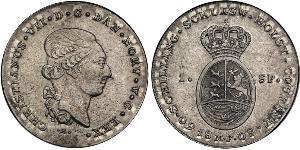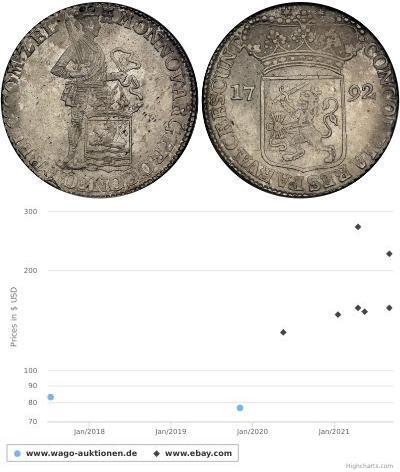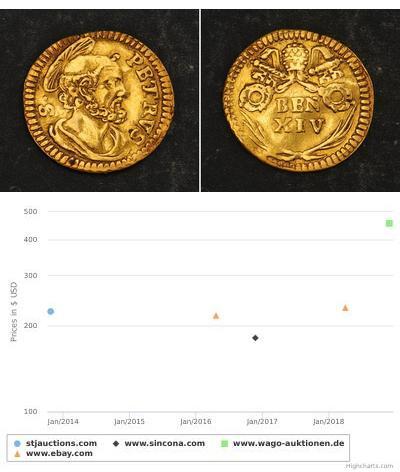2 Krone Denmark Silver Christian IX of Denmark (1818-1906)
1892, Denmark, Christian IX. Beautiful Silver 2 Kroner “Golden Wedding” Coin.
Mint Year: 1892
Reference: KM-800.
Denomination: 2 Kroner
Mint Place: Copenhagen (heart)
Material: Silver (.800)
Diameter: 31mm
Weight: 15gm
Obverse: Conjoined busts of Christian IX and and Queen Louise right. Date (1892) below, flanked by privy mark (heart) and mint official´s initials (CS).
Legend: KONG CRHISTIAN X DRONNING LOUISE
Reverse: Date (26 MAI) and anniversary dates (1842-1892) wiithin wreath. Value (2 KRONER) above.
Princess Louise Caroline of Hesse-Kassel (German: Luise Karoline von Hessen-Kassel; 28 September 1789 – 13 March 1867) was the consort of Friedrich Wilhelm, Duke of Schleswig-Holstein-Sonderburg-Glücksburgand the matriarch of the House of Schleswig-Holstein-Sonderburg-Glücksburg,1 which would eventually become the ruling house of the kingdoms of Denmark, Greece, Norway, and, barring unforeseen circumstances, the United Kingdom.
Christian IX (8 April 1818 – 29 January 1906) was King of Denmark from 16 November 1863 to 29 January 1906. He became known as the father-in-law of Europe, as his six children married into other royal houses; most current European monarchs are descended from him.
He was born in Gottorp, the fourth son of Friedrich Wilhelm, Duke of Schleswig-Holstein-Sonderburg-Glücksburg and Louise Caroline, Princess of Hesse. Through his mother, Christian was a great-grandson of Frederick V of Denmark, great-great-grandson of George II of Great Britain and descendant of several other monarchs, but had no direct claim to any European throne.
Through his father, Christian was a member of a junior male branch of the House of Oldenburg and a prince of the Schleswig-Holstein-Sonderburg-Glücksburg line, a junior branch of the family which had ruled Denmark for centuries (he was a direct male-line descendant of King Christian III of Denmark) and was (albeit a junior) agnatic descendant of Helwig of Schauenburg (countess of Oldenburg), mother of King Christian I of Denmark, who was the “Semi-Salic” heiress of her brother Adolf of Schauenburg, last Schauenburg duke of Schleswig and count of Holstein. As such, Christian was eligible to succeed in the twin duchies of Schleswig-Holstein, but not first in the line.
He grew up in Denmark and was educated in the Military Academy of Copenhagen.
As a young man, he unsuccessfully sought the hand of his third cousin Queen Victoria in marriage. At the Amalienborg Palace in Copenhagen on 26 May 1842, he married Louise of Hesse-Kassel (or Hesse-Cassel), a niece of Christian VIII.
In 1847, under the blessing from the great powers of Europe, he was chosen as heir presumptive after the extinction of the most senior line to the Danish throne by Christian VIII, as the future Frederick VII seemed incapable of fathering children. A justification for this choice of heir was Christian’s wife Louise of Hesse-Kassel. (As a great-niece of Christian VII, she was a closer heir to the throne than her husband.)
Christian succeeded upon his death Frederick VII to the throne on 15 November 1863. Denmark was immediately plunged into a crisis over the possession and status of Schleswig and Holstein, two provinces to Denmark’s south. Under pressure, Christian signed the November Constitution, a treaty that made Schleswig part of Denmark. This resulted in a brief war between Denmark and a Prussian/Austrian alliance in 1864. This Second war of Schleswig’s outcome was unfavorable to Denmark and led to the incorporation of Schleswig into Prussia in 1865. Holstein was likewise incorporated into Prussia in 1865, following further conflict between Austria and Prussia.
Frederick’s childlessness had presented a thorny dilemma and the question of succession to the Danish throne proved problematic. Denmark’s adherence to the Salic Law and a burgeoning nationalism within the German-speaking parts of Schleswig-Holstein hindered all hopes of a peaceful solution. Proposed resolutions to keep the two Duchies together and as a part of Denmark proved unsatisfactory to both Danish and German interests. While Denmark had adopted the Salic Law, this only affected the descendants of Frederick III of Denmark, who was the first hereditary monarch of Denmark (before him, the kingdom was officially elective). Agnatic descent from Frederick III ended when Frederick VII died. At that point, the law of succession promulgated by Frederick III provided for a Semi-Salic succession. There were however several ways to interpret to whom the crown could pass, since the provision was not entirely clear as to whether a claimant to the throne could be the closest female relative or not.
As the nations of Europe looked on, the numerous descendants of Helwig of Schauenburg began to vie for the Danish throne. Frederick VII belonged to the senior branch of Helwig’s descendants. In 1863, Frederick, Duke of Schleswig-Holstein-Sonderburg-Augustenburg (1829–1880) (the future father-in-law of Kaiser Wilhelm II of Germany), proclaimed himself Frederick VIII of Schleswig-Holstein. Frederick von Augustenburg became the symbol of the nationalist German independence-movement in Schleswig-Holstein, after his father (in exchange for money) renounced his claims as first in line to inherit the twin-duchies of Schleswig and Holstein. Following the London protocol of 8 May 1852, which concluded the First war of Schleswig and given his father’s renunciation, Frederick was deemed ineligible to inherit.
The closest female relatives of Frederick VII were his paternal aunt, Louise, who had married a scion of the cadet branch of the House of Hesse, and her daughters. However, they were not agnatic descendants of the royal family and thus not eligible to succeed in Schleswig-Holstein.
The dynastic female heiress reckoned according to the original law of primogeniture of Frederick III was Caroline of Denmark (1793–1881), the childless eldest daughter of the late king Frederick VI. Along with another childless daughter Wilhelmine of Denmark (1808–1891), Duchess of Glücksburg, and sister-in-law of Christian IX, the next heir was Louise, sister of Frederick VI, who had married the Duke of Augustenburg. The chief heir to that line was the selfsame Frederick of Augustenborg, but his turn would have come only after the death of two childless princesses who were very much alive in 1863.
The House of Glücksburg also held a significant interest in the succession to the throne. A more junior branch of the royal clan, they were also heirs of Frederick III, through the daughter of King Frederick V of Denmark. Lastly, there was yet a more junior agnatic branch that was eligible to succeed in Schleswig-Holstein. There was Christian himself and his three older brothers, the eldest of whom, Karl, was childless, but the others had produced children, and male children at that.
Prince Christian had been a foster “grandson” of the ‘grandchildless’ royal couple Frederick VI and his queen consort Marie (Marie Sophie Friederike of Hesse). Familiar with the royal court and the traditions of the recent monarchs, their young ward, Prince Christian was great-nephew of queen Marie, and descendant of a first cousin of Frederick VI. He was brought up as Danish, having lived in Danish-speaking lands of the royal dynasty, and had not become a German nationalist which made him a relatively good candidate from the Danish point of view. As junior agnatic descendant, he was eligible to inherit Schleswig-Holstein, but was not the first in line. As descendant of Frederick III, he was eligible to succeed in Denmark, although here too, he was not first in line.
In 1842, Christian married Princess Louise of Hesse, daughter of the closest female relative of Frederick VII. Louise’s father and brother, both princes of Hesse, and elder sister too, renounced their rights in favor of Louise and her husband. Prince Christian’s wife was now the closest female heiress of Frederick VII.
In 1852, the thorny question of Denmark’s succession was resolved by legislation through which Christian was chosen to succeed Frederick VII as the country’s next reigning monarch.
Christian IX was the 1,007th Knight of the Order of the Golden Fleece in Spain in 1864 and the 744th Knight of the Order of the Garter in 1865.
When Frederick died in 1863, Christian assumed the throne as Christian IX.
In November 1863 Frederick of Augustenburg claimed the twin-duchies in succession after King Frederick VII of Denmark, who also was the Duke of Schleswig and Holstein, and who had died without a male heir.
In 1864, Prussia and Austria initiated the Second war of Schleswig which eventually led to the Danish loss of both South Jutland and Holstein.
| 1 | 2 |
|---|
(1537 X 737 pixels, file size: ~207K)
Posted by: anonymous 2018-11-23
1892, Denmark, Christian IX. Silver 2 Kroner "Golden Wedding" Coin. AU++ Mint Year: 1892 Reference: KM-800. Denomination: 2 Kroner Condition: A nice AU++ Mint Place: Copenhagen (heart) Material: Silver (.800) Diameter: 31mm Weight: 15gm Obverse: Conjoined busts of Christian IX an ...
(3203 X 1600 pixels, file size: ~904K)
Posted by: anonymous 2024-03-31
DENMARK 2 Kroner 1892 (h) - Silver 0.800 - Golden Wedding Ann. - 1324
(3205 X 1569 pixels, file size: ~1M)
Posted by: anonymous 2023-12-30
Untitled Document 1892, Denmark, Christian IX. Beautiful Silver 2 Kroner "Golden Wedding" Coin. Mint Year: 1892 Reference: KM-800. Denomination: 2 Kroner Condition: Minor deposits, otherwise a nicely toned AU+ Mint Place: Copenhagen (heart) Material: Silver (.800) Diamet ...
(900 X 452 pixels, file size: ~160K)
Posted by: anonymous 2016-12-03
Dänemark, Christian IX. 2 Kroner 1892. Goldene Hochzeit. K.M. 800, Hede 11. Prachtexemplar. Schöne Patina. Fast Stempelglanz
(900 X 455 pixels, file size: ~112K)
Posted by: anonymous 2016-05-01
Dänemark, Christian IX. 2 Kroner 1892. Goldene Hochzeit. K.M. 800, Hede 11. Prachtexemplar. Schöne Patina. Winziger Randfehler, fast Stempelglanz / Stempelglanz
(900 X 454 pixels, file size: ~113K)
Posted by: anonymous 2015-11-27
Dänemark, Christian IX. 2 Kroner 1892. Goldene Hochzeit. K.M. 800, Hede 11. Prachtexemplar. Schöne Patina. Fast Stempelglanz





















